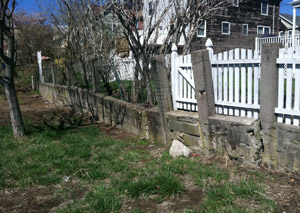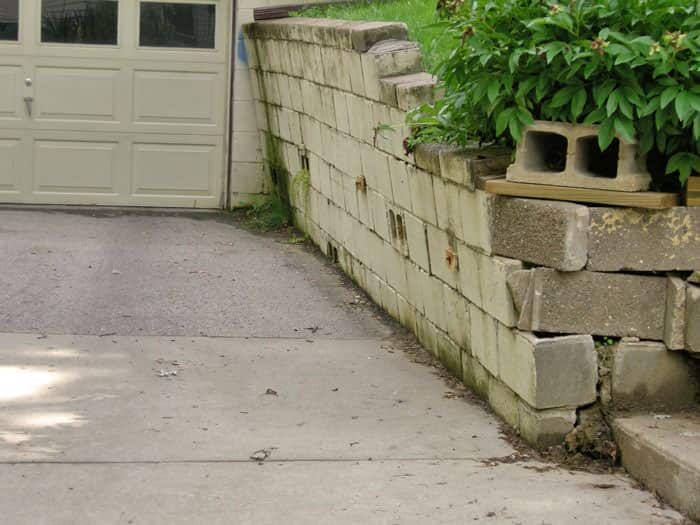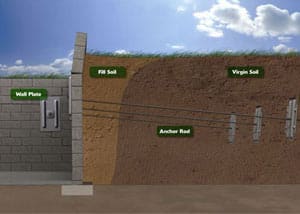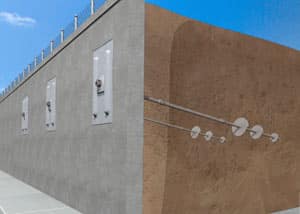Retaining Wall Repair in Pennsylvania and New York
Repairing crumbling and failing retaining walls
Retaining walls serve to retain the lateral pressure of soil. More simply, retaining walls are used to hold back soil and substrate from moving due to the effects of gravity and erosion. Retaining walls are typically designed out of concrete, stone, wood (including railroad ties), vinyl, masonry, steel, or brick.
Our experts offer Erie retaining wall repair, wall anchors, crack filling, helical tiebacks, and a host of other services to help repair any problem you may have. If your retaining wall is tilting, separated from adjoining walls, buckling, cracked, or crumbling, Total Foundation Solutions can provide you with an expert repair solution. Our foundation wall experts can identify the cause of the problem and restore your wall to its original condition.

Retaining walls are common along roadways, parking lots, and bodies of water. Basement walls are also a type of retaining wall -- and similar repair options are available for both.
Identifying retaining wall failure
Our Erie retaining wall repair and crack filling specialists have come across many telltale signs that point to a failing retaining wall. Most of these signs are easy to identify, but it's important to know that these symptoms will become increasingly worse over time. Unless proper repairs are made, the wall will eventually fail completely.
Most often, a retaining wall will show signs of failure in one of three ways:
- Collapsing/tilting retaining walls: Soil issues and/or poor construction are often the culprits for retaining walls that are tilting. This can happen if the footing toe is too small or if the wall wasn't properly reinforced. Railroad tie retaining walls can begin to collapse due to wood rot or deterioration. Most retaining walls require drainage "weeps". If water accumulates behind the wall, this additional weight can cause clay soils to expand, leading to cracks and tilting.
- Retaining walls separating from adjacent walls: Like collapsing/tilting retaining walls, walls that are separating from adjacent walls are often caused by poor quality construction. A separating retaining wall may not have been designed to withstand the weight that actually bears on the wall. Poor drainage and inadequate reinforcement or connection to the adjacent wall are other possible causes. In unusual cases, expansive soils may also cause a retaining wall to separate from an adjoining wall.
- Crumbling/failing retaining walls: Retaining walls can crumble for a wide variety of reasons, most related to improper design of the walls itself. Often, the wall was not made to bear the weight load behind it. In the case of concrete retaining walls, the issue may be inadequate, weak, or poorly mixed concrete. Concrete retaining walls may also have been designed with inadequate steel rebar, resulting in insufficient strength.

Collapsing retaining walls will eventually fail if not properly addressed with a permanent repair solution.
Repairing retaining walls
To repair retaining walls, Total Foundation Solutions typically recommends either wall anchors or helical tiebacks to restore structural integrity. Both wall repair techniques use a strong steel wall bracket on the exterior of the retaining wall to brace the wall and properly distribute the anchor's clamping pressure.
We have found that during our retaining wall repairs in Erie, wall anchors and helical tiebacks gave us the flexibility and control to not only restore the structural integrity, but to also completely restore its appearance, making it look like nothing even happened.
Wall anchors accomplish this by driving an anchor rod through 1" holes driven into the retaining wall. These rods are connected to earth anchors that are placed within augured holes within the soil beyond the retaining wall. Once assembled, the wall plate is installed, and the rod assembly is tightened. This can potentially straighten the wall and return it to its original position.
Helical anchors are installed from the exposed face of the retaining wall, through a hole cut in the wall. The anchor's helical blades help to pull it deep into the soil and anchor it there. After closing the hole in the retaining wall, a wall plate is installed and a nut is tightened over the protruding threaded rod to brace the wall.
Wall anchors are generally the more economical solution to repairing a retaining wall. However, in some cases, wall anchor installation is not a possibility, and helical anchor installation must be considered. This includes situations where rocky soil is an issue, or when space restrictions make auguring a hole beyond the retaining wall an impractical solution. Our Erie retaining wall repair specialists will be able to advise you on the most appropriate solution.


(Above) A wall anchor system relies on the fixed position of an earth anchor and clamping pressure from an anchor rod.
(Below) A helical anchor system utilizes helix-shaped plates welded to the anchor shaft to pull the anchor deep into the soil.
We repair retaining walls in PA and NY!
At Total Foundation Solutions, we provide warrantied solutions for retaining wall repair throughout Pennsylvania and New York. For homeowners interested in learning more about their unique problem, we offer free, written retaining wall repair quotes at no obligation.
